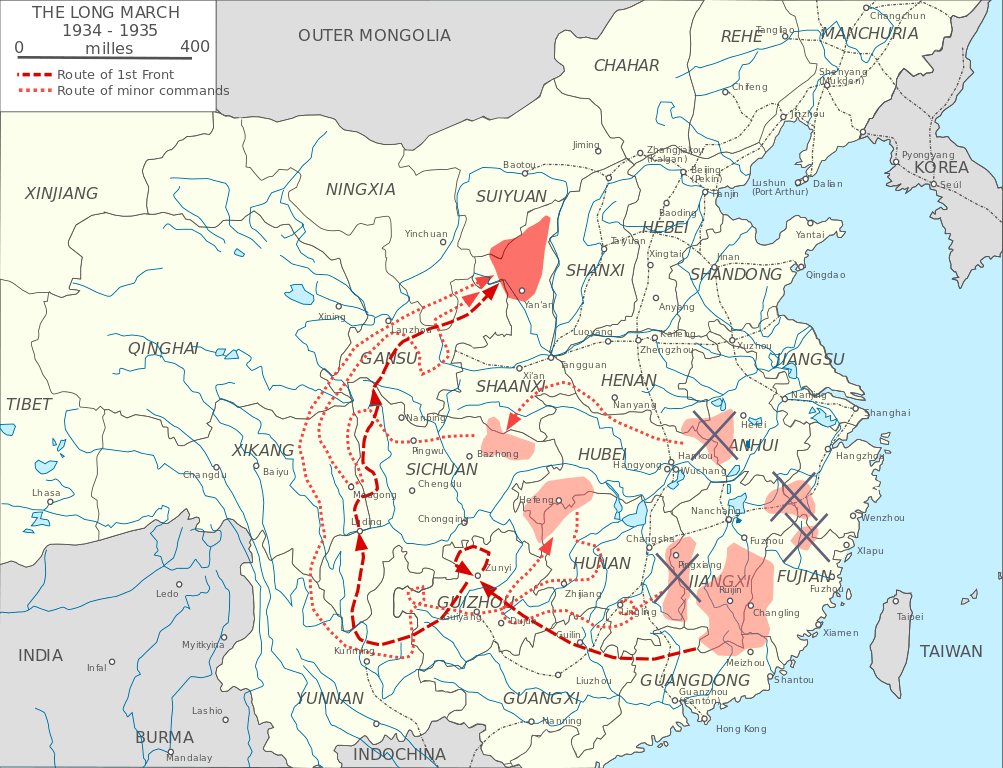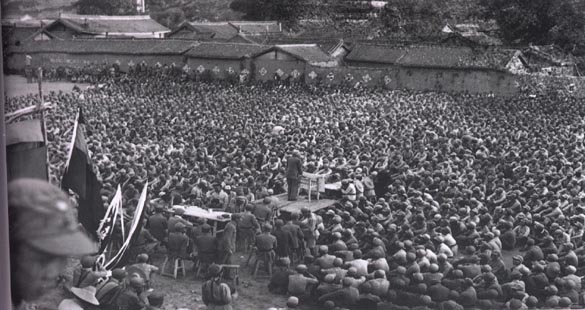 |
| Long March |
By late summer of 1934, the fifth encirclement campaign, led by Chiang Kai-shek, had convincingly defeated the Chinese Communist Soviet and reduced it to a six-county area in Jiangxi (Kiangsi) Province.
On October 15 the Communist government abandoned its capital, Ruijin (Juichin), with 85,000 soldiers, 15,000 party and government officials, and 35 women (wives of the high officials). They began the Long March, which would last for one year and cover about 6,000 miles (called the 25,000 li Long March in Chinese).
The Communists were able to break out of the eastern sector of the Nationalist encirclement because it was guarded by army units under dissident generals whom Chiang did not control and whose leaders feared that the elimination of the Communists would hurt them.
  |
The fleeing Communists were allowed to escape through a narrow corridor on the border of Guangdong (Kwangtung) and Guangxi (Kwangsi) (ruled by Nationalist generals who were opponents of Chiang) and entered Guizhou (Kueichow). Guizhou province, the domain of a corrupt warlord who grew rich from opium, was unable to prevent the Communist incursion.
In January 1935 the communists held a conference at Zungyi (Tsungyi) in Guizhou where Mao Zedong (Mao Tse-tung) and his allies Zhou Enlai (Chou En-lai), and Zhu De (Chu Teh) emerged victorious, blaming the previous defeats on their opponents in the party.
They then decided to head for northern Sha'anxi (Shensi) Province, where a Communist base already existed. Chased out of Guizhou by Chiang's pursuing forces, the Communists headed for Yunnan, Sichuan (Szechuan), Sikang, and Gansu (Kansu) Provinces and were evicted from each in succession.
Mao and 8,000 survivors reached northern Sha'anxi in October 1935; others who arrived later boosted the total to 30,000. They established themselves in Yanan (Yenan), which would remain their headquarters until 1949.
The Long March was an epic of survival for the Chinese Communists: They survived terrible terrain and their pursuers. Although severely reduced in numbers, the leadership emerged intact. Mao became the clear leader of both the party and the military after the Zunyi Conference and would continue to dominate both until his death in 1975.
Although Chiang Kaishek could not eliminate the Communists the encirclement campaigns and the Long March also clearly strengthened both Chiang and the central government of the Nationalist Party (Kuomintang). Ending the Chinese Communist rebellion in Jiangxi consolidated government power in southeastern China.
 |
| Long march survivors |
Importantly, the inability of the autonomous warlords in Guizhou, Yunnan, Sichuan, Sikang, Gansu, and Sha'anxi Provinces to prevent the Communists from invading their domains led to central government troops entering these areas. After expelling the Communist invaders the government units remained and imposed many reforms and changes, which reduced the warlords to semiobedience to the national government.
This was crucial for China's survival when Japan invaded in 1937 and seized the coastal regions, enabling the Chinese government to continue resisting Japan for eight years from its new base in Sichuan and the other provinces it had gained control of as a result of the Long March.